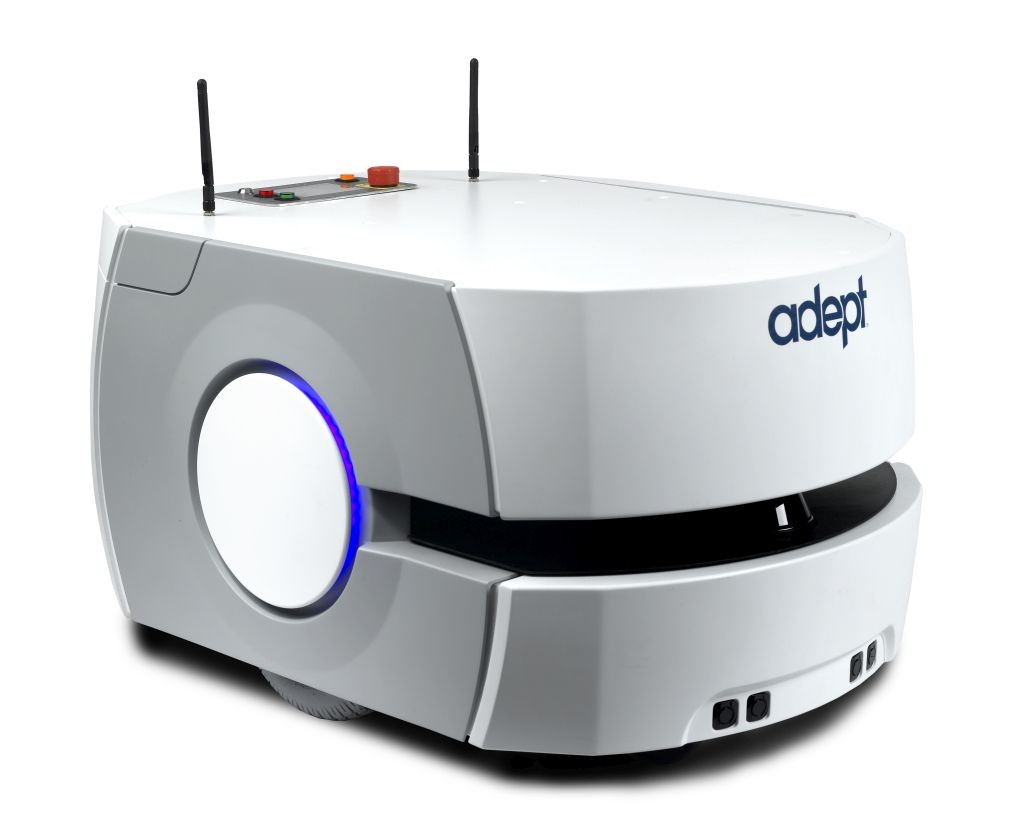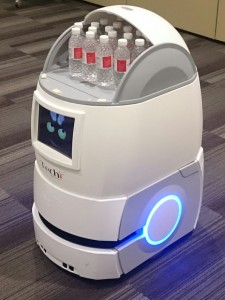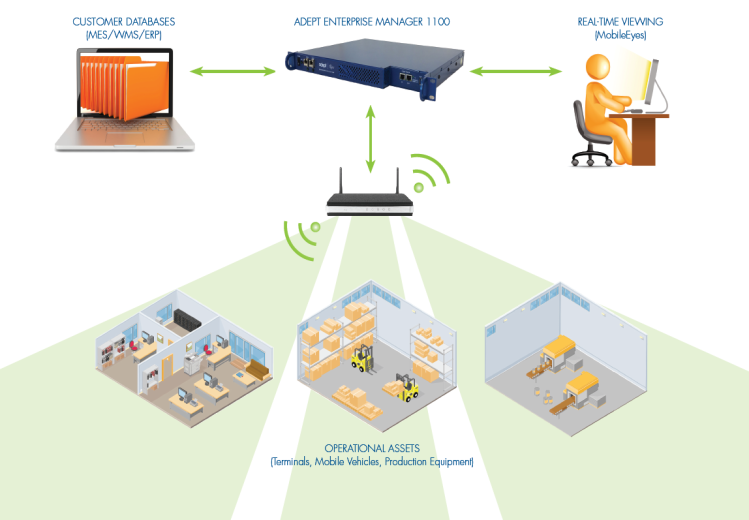
Robohub.org
SVR Case Studies: Adept’s versatile mobile service platform

Lynx mobile robot platform can be adapted for many applications. Source: adept.com
Interview with Michael Oitzman, Sr. Product Line Manager, Adept Mobile Robots
courtesy of Tanya Anandan, for A3 Association for Advancing Automation
(edited for clarity)
What are the current markets and types of applications for Adept mobile robots in the service robotics sector?
Service robotics is a small, emerging part of our main target markets (manufacturing, warehouse/ logistics and semiconductor). We have begun to explore this market space through several partners that have deep market knowledge and established customer relationships. We are finding that the Lynx platform is flexible enough to address many growth opportunities in this space.
Hospitality
I want to start with Techmetics because it’s been an interesting relationship. We built and designed the Lynx to be an OEM platform for customers and partners to white label our solution, to take our technology and build onto that base with an application payload on top of it. That’s exactly what Techmetics has done.

Techi is a new service robot configured to serve food in restaurants.
Techmetics’ forte is in point-of-sale systems. That’s the technology that they’ve had for many years; these are systems for ordering and paying for food. The natural extension for them is robotic delivery. This fall they’re going to start installing multiple robots into their customer base to be robotic waiters (called Techi, as seen in this video). That will be the first application that they deploy. I think it’s a very interesting opportunity because the Lynx technology fits so well into that space because of its unique ability to navigate safely and reliably through very dynamic environments.
So we’re excited about that, and then the same thing with their robotic butler in hotels (video). There’s a lot of opportunity in Southeast Asia, especially in Singapore, which is where they are launching. Reduction of labor costs is a large focus in Singapore. The Singapore government has provided some funding to get them started in this application. Employers can replace the manpower of three servers with the Techi robot and have an ROI of less than a year.
With Techmetics, they have a couple of interesting applications that they are bringing to market and we’re going to see them grow over this coming year. We’re very excited about supporting them going forward.
Healthcare
We’ve also developed the Lynx Courier AIV, which is a vehicle that we sell completely configured. It’s available in either an enclosed or open configuration. The vehicle includes sliding shelves for holding the cargo. We designed that vehicle for hospitals, for carrying lab samples or for moving materials from the pharmacy out to the wards. That was an evolution with our friends at Swisslog. We’re continuing to work on the next generation of vehicles deploying to hospitals. Regionally, we’re also working with new partners such as the Lamson Group in Australia to go after healthcare applications in those markets (video).
An Adept press release referred to the first commercial use of its mobile robots as far back as 2010. Was that this partnership with Swisslog?
Yes, that was the prior generation. Before the Lynx, we had the MT-400. When we acquired MobileRobots, the MT-400 was the first generation Industrial Mobile Robot. Then we created a couple of application payloads on top of that vehicle, one of which is the Courier generation. That’s what Swisslog incorporated into their OEM product (RoboCourier®, as seen in this video).
Then two years ago when we released the Lynx, it was an entirely new design optimized for high reliability and flexibility. The software also evolved during those years. From this newer generation of the OEM platform we created the Lynx Handler SEMI, which is the semiconductor- specific vehicle. The Lynx Handler incorporates a collaborative SCARA robot on top of the Lynx mobile base. Our largest installed base right now is into the semiconductor industry. That’s where we matured the fleet management solution (Adept’s software tool for managing multiple robots is called Enterprise Manager).

The Lynx Enterprise Manager fleet management software coordinates multiple robots’ jobs.
Outside of manufacturing and logistics, those are the service applications that we have in terms of what I can talk to you about now.
How did these markets evolve or how did Adept choose these service market areas for concentration?
Our focus has been primarily on our three target markets as I mentioned. We wanted to get the operation and reliability in terms of the core navigation, safety, mapping and programming technology to meet the demands of these markets. Our partners in the service industry saw the performance of our Lynx product and realized that it was a great platform for their application space. They quickly adopted the technology and began to share the new capabilities with their customers.
Do these partners come to you or is it the other way around?
It’s a bit of both. We look strategically for the right opportunities and then we have partners that have come to us because they love our platform and don’t want to re-engineer everything. For those partners, like Techmetics, our advantage is what can be put on top of our solid platform.
What is a typical day like for the robot working in a hospital?
The hospital Couriers operate throughout the day, making deliveries as needed. When the robots aren’t driving, they’ll sit and charge to make sure that they are ready to go. That’s a pretty straightforward application for the Enterprise Manager, where there’s more than one vehicle operating and they’re running routes to a variety of pick-up and drop-off points.
How does the robot learn the routes and understand the layout of the hospital?
This is part of the core technology. Our mapping technology is done using the vehicle, so you just have to walk the robot around the facility once. You simply show the robot every place it could potentially drive, and we use the drive navigation laser to do the mapping. Then we generate an accurate facility map, which will be used by all of the robots for path planning and navigation.
Here’s the interesting part about the Lynx Enterprise Manager solution – all the robots in the fleet share the same map, so when you edit the map for any reason all of the Lynx units are automatically updated with the new information. They’re all on Wi-Fi. That’s how the robots communicate with the Enterprise Manager.
Then on the map you designate the areas that are forbidden, where you don’t want the robot to drive. If you never want the robot to drive down a certain hallway, you put a forbidden zone there and the robot will never enter that spot. Or you can assign one-way aisles, so the robot will always drive in one direction in this aisle. Or you can designate two-way directional sections where the robot will hug the right or the left side of the aisle, or follow any preferred traffic pattern.
Who usually does that programming or tweaking?
The Lynx software interface is designed to be very intuitive and is easy for the end user to configure. Typically one or two end users attend a short training course.
Once you set up the map, the robots are then on their own to decide how they get from point A to point B based on the map features. So the robot will path plan through the facility and then if an obstacle appears in the path of the robot, for example, a door is shut or there’s a gurney parked in the way, or if there’s a bunch of boxes or a ladder, or anything that’s temporary that it might encounter, the robot will see that with its drive laser and will path plan an alternative route around the facility based on the definition of all the map features.
Enterprise Manager is required anytime you have two or more mobile robots operating in the same workspace. With Enterprise Manager in place, when both of those vehicles need to cross each other’s path, it will inform the other robot that there is a robot ahead and it’s going to go to its right, so you need to go to your right and drive around it. It will have a much faster and cleaner path planning without having to stop temporarily. And at intersections Enterprise Manager will give one robot the right of way. That sort of algorithmic decision making is built into Enterprise Manager to help the fleet be more efficient.
What other types of onboard technology support the robot’s performance?
One thing about our platform, because our primary markets are in industrial and warehousing, everything on our system is hardened for that environment. We’re perfectly comfortable taking it out of the warehouse and putting it into another environment with humans, where maybe the regulations aren’t as developed as they are in the warehouse or on the manufacturing floor. There’s no one else on the market today that’s using that level of technology in service robotics.
Lynx is a collaborative robot, interacting safely alongside people. We’ve designed the system with all the safety sensors and control architecture that make the system collaborative.
Then you have a sonar package on the front and the back of the robot for looking at things that might appear in its path. We have the option to include vertical lasers as well. That means we can put a vertical light curtain around the sides of the payload. The worst obstacle for a mobile robot would be a table where it only sees the legs and thinks it could navigate between those legs. Yet potentially you could have the payload located at the tabletop level. In that case, the vertical lasers would be able to spot that tabletop.
We have a very unique solution in something we call Acuity. Acuity is the option we developed because LIDAR (Light Detection and Ranging, or laser radar) by itself is not capable of operating successfully in a complex, dynamic environment. Any mobile robot using LIDAR and SLAM (Simultaneous Localization and Mapping) can get lost if the route is too different from the reference map that it’s using to navigate. With Acuity we use an upward-facing camera placed on top of the vehicle for a 120-degree view. The vehicle looks up at the lights in the ceiling and uses those lights to triangulate its position. As it drives, it keeps looking for the next set of lights to come into view and it uses that to keep it localized in the world.
The vehicle itself has digital I/O and analog I/O so we’re able to control active elements on the payload. We also provide electrical power at various regulated voltages supplied from the robot’s battery. That’s actually how we power the robots that are running on top of our semiconductor applications. In addition to the robots, in the payload section, people are putting PLCs there. Techi (the hospitality robot) has the little tablet with its eyes, and that tablet communicates with the robot core to anticipate where it’s driving.
What kind of feedback have you received from customers/end users?
The units we have deployed are all performing very well. It is interesting to see our customers give the robots individual names and almost treat them as fellow employees! The advanced navigation capability really allows these robots to operate autonomously without any interaction or support. If we go back to the warehousing and manufacturing, we have some very happy customers that are just thrilled with the technology and what it’s been able to do. I think our newest service industry customers will see that same sort of value.
How do these robots provide value in each application? Typical return on investment?
We’re trying to design a solution that can give customers an ROI in a year. Techi is replacing waiters. They’re reducing the staff and then all the overhead costs of hiring and training that labor. Singapore is also a high-tech market. They’re used to having high-tech gadgets, so I think there’s a bit of novelty to it as well.
In the hospital environment, it’s about making people more productive so they can focus on more value-added tasks. There are also intangibles about predictability and traceability. Things are sent from one point to another and it is guaranteed that they are going to arrive intact and on time.
How significant of a role does Adept’s experience in the industrial sector play in the service sector and what have you learned from the industrial sector that you can apply to the service area?
The semiconductor market is extremely demanding, because time is money in a fab. Those robots run 24 hours a day, 7 days a week. They don’t even have time to charge the batteries on the robots. They swamp out the batteries between shifts. So from a systems stress standpoint, the fabs have been a true test of industrial reliability and have resulted in a robust product platform. Every other customer that’s come afterwards is now gaining the advantage of having worked through those situations in the fabs. We’ve learned a lot from those robots being deployed, so we’ve improved the reliability of the robots.
I think that’s a key buying criteria for those partners because they know that we design and build robust solutions. We have solutions that are designed and engineered to function in the industrial world and we’re bringing them into the consumer space where, if we have a partner that has a need, we have a platform that is fully featured and supported globally.
What are the main differences or new challenges you’re encountering in the service area?
The Lynx software for me is the enabler for service industry applications. The software will likely require specific capabilities that will need to evolve to get better across all these markets.
Does Adept’s reputation precede it or do you sometimes feel like a startup?
We have the advantage of taking the relatively new technology of mobile robots and leveraging our deep knowledge and experience of fixed industrial robotics and automation. We are trying to innovate at a very fast pace to address market demand. We’re growing the technology quickly and are working to be more nimble in terms of how we can design and evolve the market. I think Techi is a great example. That opportunity came to us and we said what can we do to help these guys with their vision. Here’s a partner that has all of the rest of the pieces put together, so it was the perfect partnership for us. Now they will take it to market in Southeast Asia and beyond.
Looking forward, what are you envisioning for Adept mobile robots?
I think it’s pretty intuitive if you look at our existing product line of fixed robots and the mobile robots. When I look at the next generation of mobile robots and the convergence of putting mobile manipulators on top of the vehicle, which is where everyone is looking to go, I think we’re a uniquely qualified organization because we have both assets in our portfolio, fixed robots and mobile robots. It’s a natural extension of our key core capabilities and a great place for us to drive towards.
Adept Technology, Inc. (NASDAQ: ADEP) is a global provider of intelligent vision-guided robotics systems, autonomous mobile robot solutions and services. Founded in 1983 and headquartered in Pleasanton, California, Adept is the largest U.S.-based manufacturer of industrial robots. On October 23, 2015, Adept was acquired by and became a wholly owned subsidiary of OMRON Corporation, a global automation manufacturer of sensing and control technology based in Japan. Product lines include SCARA, parallel, and six-axis robots; linear modules; mobile robots; machine controllers for robotics and other flexible automation equipment; machine vision; and software. The company’s core markets include manufacturing, warehouse/logistics, electronics, semiconductor and food.
Adept distributes and supports its products worldwide both directly and through channel partners. Around the globe, more than 68,000 robotic systems are installed with either Adept robots or robot controllers.
In 2010, Adept acquired MobileRobots, Inc., a strategic move positioning the multinational to explore commercial and industrial applications for the burgeoning mobile robots market. The flagship of its mobile robots product line is the Lynx® Autonomous Intelligent Vehicle (AIV) (video), which serves as the mobile platform for various payload solutions incorporating robotic manipulators, shelving systems, cart transportation and channel partners’ human machine interface technologies. The majority of Adept’s customer base for its mobile robots is in the industrial sector, including manufacturing, warehousing and logistics, and semiconductor fabs. Emerging and still evolving markets in the service robotics sector include hospitality and healthcare.
The rest of the Silicon Valley Robotics free report on service robotics is AVAILABLE HERE — or in instalments at Silicon Valley Robotics — featuring case studies and analysis from industry experts and investors.
tags: Adept mobile robots, silicon valley robotics, SVR, Techmetics




